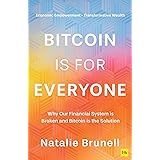Safely Buying Crypto in the Philippines: A Beginner’s Guide to Digital Asset Ownership
Embarking on your journey to buy cryptocurrency, especially in the Philippines, demands a solid grasp of foundational principles and robust security measures. While the video above provides an excellent visual introduction to the process, this guide expands on those critical aspects, equipping you with the deeper insights needed to navigate the dynamic world of digital assets securely and confidently. We’ll delve into the intricacies of self-custody, cybersecurity, and platform selection, ensuring you’re well-prepared for your first crypto purchase.
1. Embracing Financial Autonomy: You Are Your Own Bank
The core philosophy behind cryptocurrency is decentralization, fundamentally shifting control from central authorities to the individual. This means that when you engage with crypto, you effectively become your own bank, responsible for the security and management of your funds. Unlike traditional financial institutions where forgetting a password might lead to a simple reset, the crypto world offers little to no recourse for user error.
Transactions on a blockchain network are immutable; once validated and uploaded, they are permanent and irreversible, like carving a message into stone. This permanence means that if you fall victim to a scam or send funds to the wrong address, retrieval is virtually impossible. Therefore, understanding and implementing stringent security protocols isn’t just a recommendation—it’s an absolute necessity for protecting your digital wealth.
2. Fortifying Your Digital Frontier: Essential Cybersecurity Practices
Securing your cryptocurrency investments begins long before you even consider making a purchase. Think of your digital presence as a fortress; every potential entry point needs to be impenetrable. Neglecting these fundamental safeguards is akin to leaving your bank vault wide open.
Here are the non-negotiable steps to bolster your cybersecurity:
-
Dedicated Crypto Email Address
Create a brand-new email address exclusively for all your crypto-related accounts and transactions. This email should be a closely guarded secret, never shared for public communication or newsletters, akin to having a separate, unlisted phone number for sensitive contacts. While standard providers like Gmail are sufficient, consider privacy-focused options such as ProtonMail for an enhanced layer of anonymity and encryption, making it significantly harder for malicious actors to trace your activities.
-
Strong, Unique Passwords
Your passwords are the first line of defense against digital intruders. Forget easily guessable combinations or substituting letters with numbers; these are elementary tactics easily cracked by sophisticated attackers. Instead, forge long, complex passwords that combine random sequences of letters (uppercase and lowercase), numbers, and symbols, ideally at least 12 to 16 characters in length.
Crucially, each crypto account must have its own unique password. Reusing passwords across multiple platforms is a critical vulnerability, as a breach on one site can compromise all your linked accounts. If remembering these intricate passwords becomes a challenge, employ a reputable password manager like Bitwarden, Dashlane, or 1Password, which encrypt and store your credentials securely, requiring you only to remember one master password.
-
Two-Factor Authentication (2FA)
Beyond passwords, 2FA adds a vital second layer of security, making it exponentially harder for unauthorized users to access your accounts. Applications like Authy or Google Authenticator generate time-based one-time passwords (TOTPs) that refresh every 20 to 30 seconds. Even if a hacker obtains your password, they would also need physical access to your device at the exact moment of login, a significant hurdle for most cybercriminals.
This multi-factor approach acts like a dual-key safe; one key is your password, and the second is the constantly changing code on your personal device. Always opt for authenticator apps over SMS-based 2FA, as SIM-swap attacks can compromise phone-based verification methods, leaving your accounts vulnerable.
3. Your Digital Vault: Understanding Crypto Wallets
The concept of a crypto wallet can be a bit counter-intuitive for newcomers. Unlike a physical wallet storing banknotes, a cryptocurrency wallet doesn’t actually “hold” your coins. Instead, it stores the crucial cryptographic keys—a public key and a private key—that give you access to your funds on the blockchain network.
Imagine your public key as your bank account number; it’s what you share with others to receive funds. Your private key, however, is akin to your bank account password or the PIN for your debit card—it grants complete control over your assets. Anyone possessing your private key gains immediate, irreversible access to your funds. The golden rule in crypto is therefore: “Not your keys, not your crypto.” If you don’t control your private keys, someone else effectively manages your assets, making them custodial rather than truly yours.
There are three primary types of crypto wallets, each with varying levels of security and convenience:
-
Software Wallets (Hot Wallets)
These wallets are “hot” because they are continuously connected to the internet, offering ease of access but inherently higher vulnerability to online threats. Software wallets manifest in several forms: web wallets (browser extensions like MetaMask), mobile wallets (apps on your smartphone like Trust Wallet or Exodus), and desktop wallets (applications installed on your computer).
While convenient for frequent trading or smaller amounts, storing substantial, long-term investments in hot wallets is generally discouraged due to their susceptibility to hacks. They are the digital equivalent of carrying your entire life savings in your pocket; convenient for immediate use, but risky for long-term storage.
-
Hardware Wallets (Cold Wallets)
Often considered the gold standard for crypto security, hardware wallets are physical devices, such as the Ledger Nano X demonstrated in the video. These “cold” wallets store your private keys offline, completely isolated from the internet, making them impervious to online hacking attempts. They function like specialized, ‘dumb’ computers designed solely to generate and sign transactions using your private key without ever exposing it online.
For investors holding significant amounts of cryptocurrency, the cost of a hardware wallet, while higher upfront, is a worthwhile investment in unparalleled security. It’s like moving your most precious valuables from a readily accessible safe into a fortified bank vault, only bringing them out when absolutely necessary for transactions.
-
Paper Wallets
A paper wallet is a physical printout containing your public and private keys (often as QR codes). While offering extreme offline security—no internet connection means no online hack risk—they come with significant practical drawbacks. If the paper is lost, damaged by water, fire, or simply becomes unreadable, your funds are permanently inaccessible.
Modern consensus largely discourages the use of paper wallets for active storage due to these high risks of physical loss or damage. They represent a highly secure, yet highly fragile, method of key storage, best reserved for niche, highly experienced users.
The Importance of Seed Phrases
Regardless of the wallet type, non-custodial wallets will typically provide you with a “seed phrase” (also known as a recovery phrase or mnemonic phrase), usually a sequence of 12 to 24 common words. This phrase is the ultimate backup for your wallet. If your device is lost, stolen, or damaged, your seed phrase allows you to restore access to your funds on any compatible wallet application or hardware device. It’s the master key to your digital vault, and it must be guarded with the utmost secrecy, ideally written down and stored offline in multiple secure, discreet locations, never digitized or shared with anyone.
4. Navigating the Philippine Crypto Landscape: Where to Buy
With your cybersecurity arsenal prepared and your wallet knowledge fortified, the next step is selecting a platform to acquire your initial cryptocurrency. The Philippines offers several accessible options, each with its own advantages and fee structures. Remember to always transfer your long-term holdings off exchanges and into your secure non-custodial wallet as soon as your purchase is complete, as exchanges, by their nature, are central points of failure and popular targets for cyberattacks.
Here’s a breakdown of popular platforms:
-
Coins.PH
As a widely used e-wallet in the Philippines, Coins.PH offers a convenient entry point for buying Bitcoin (BTC), Bitcoin Cash (BCH), Ethereum (ETH), and Ripple (XRP). Its user-friendly interface makes it straightforward to convert PHP into crypto. However, convenience often comes at a cost; the platform is known for its wider spread—the difference between the buying and selling price—which can make purchases comparatively more expensive than on dedicated exchanges. For serious investors, it’s crucial to acknowledge these higher rates. While easy to use, always transfer your acquired crypto from Coins.PH to your private non-custodial wallet to ensure true ownership.
-
PDAX (Philippine Digital Asset Exchange)
PDAX is a local cryptocurrency exchange that supports a broader range of assets including Bitcoin, Bitcoin Cash, Litecoin, Ethereum, and Ripple. The platform is actively engaged in crypto education and expansion within the Philippine market. While PDAX offers trading from as low as 52 PHP, its withdrawal fees can be on the higher side. To optimize for fees, it’s generally advisable to deposit and trade larger amounts. For new users, promotional codes (like “Nicole” for a 30 PHP bonus on a 1,000 PHP cash-in mentioned in the video) can offer a small starting advantage, demonstrating the platform’s efforts to attract new users.
-
Paxful (Peer-to-Peer Trading Platform)
Paxful stands apart as a peer-to-peer (P2P) trading platform, directly connecting buyers and sellers of Bitcoin. This model offers immense flexibility in payment methods, including bank transfers, PayPal, GCash, Western Union, and even gift cards. The P2P nature allows for competitive pricing, as various vendors offer Bitcoin at different rates. Paxful employs an escrow system to secure trades; the seller’s Bitcoin is locked until the buyer confirms payment, mitigating risks. This platform is particularly favored for its diverse payment options and potential for securing better rates, often making it a go-to for frequent Bitcoin buyers.
-
Crypto.com
Crypto.com is a global powerhouse offering a comprehensive suite of crypto services, from convenient in-app cryptocurrency purchases to an exchange, and even interest-earning accounts. The platform supports a vast array of cryptocurrencies and is noted for its high interest rates on deposited crypto, which can be significantly more attractive than traditional banking. Their ecosystem also features a metal debit card, which requires staking (locking up) a certain amount of their native MCO token to unlock benefits. For those looking for an all-encompassing crypto experience, including earning passive income on their holdings, Crypto.com presents a compelling option, often sweetened with referral bonuses (like the $50 for both parties upon staking 50 MCO).
5. A Step-by-Step Crypto Purchase: The Paxful Example
Let’s walk through a typical Bitcoin purchase on a P2P platform like Paxful, as demonstrated in the video. The process is designed to be secure and transparent:
-
Identify a Vendor
After navigating to the “Buy Bitcoin” section, you’ll see a list of available sellers. Each vendor will display their price, buying limits (minimum and maximum amounts you can purchase), and accepted payment methods. It’s crucial to select a vendor whose limits align with your budget and whose payment methods are convenient for you.
-
Initiate a Trade Request
Once you select a vendor, you’ll specify the amount of Bitcoin you wish to purchase in your local currency (e.g., 1,000 PHP). The platform will automatically calculate the equivalent Bitcoin amount. At this point, the seller’s Bitcoin is moved into an escrow account, ensuring it’s held securely until the transaction is completed.
-
Complete Payment
The vendor will provide their payment details (e.g., bank account number for a bank transfer). You then proceed to make the payment using your chosen method. Some vendors, especially for first-time trades or larger amounts, may require identity verification, such as submitting a photo ID, before releasing payment details.
-
Confirm Payment and Await Release
After successfully transferring the funds, you must mark the trade as “paid” on the Paxful platform and upload proof of transaction (e.g., a screenshot of your bank transfer receipt). The vendor then verifies your payment. This verification process typically takes a few minutes, but can sometimes extend to an hour depending on the vendor’s responsiveness. Once verified, the Bitcoin held in escrow is released directly into your Paxful wallet.
6. Mastering Your Assets: Transferring Crypto to Your Wallet
Acquiring Bitcoin on an exchange or P2P platform is just the first step; the crucial next move is to transfer your digital assets to your personal, non-custodial wallet. This step is fundamental to exercising true ownership and mitigating exchange-related risks.
-
Locate Your Wallet Address
Open your chosen non-custodial wallet (e.g., your Ledger Nano X, Trust Wallet app, or Exodus desktop client) and navigate to the “Receive” section for the specific cryptocurrency you wish to transfer (e.g., Bitcoin). This will display your public wallet address, a long string of alphanumeric characters, which acts as the destination for your funds.
It’s imperative to ensure you’re copying the correct address for the corresponding cryptocurrency. Sending Bitcoin to an Ethereum address, or vice versa, will result in permanent loss of funds, a mistake that is irreversible due to blockchain immutability.
-
Initiate Withdrawal from the Platform
On your crypto buying platform (e.g., Paxful, PDAX, Crypto.com), go to the “Withdraw” or “Send” section. You’ll specify the amount of cryptocurrency you want to transfer and paste your copied wallet address into the destination field. Always double-check this address character by character, or by using the copy-paste function reliably, to avoid costly errors.
-
Confirm with 2FA
Most reputable platforms will require you to confirm the withdrawal using your 2FA authenticator app, adding another layer of security to prevent unauthorized transfers. This ensures that even if someone gained access to your platform login, they couldn’t move your funds without your secondary authentication.
-
Monitor the Transaction
After initiating the withdrawal, the transaction will be broadcast to the blockchain network. It’s important to note that transfers are not instantaneous. Depending on network congestion, the chosen transaction fee, and the specific cryptocurrency, it can take anywhere from 30 minutes to an hour (or even longer during peak times) for your transaction to be validated by the network and reflect in your personal wallet. You can often track the transaction status using a blockchain explorer with the transaction ID provided by the platform.
The journey of **buying crypto** and managing your digital assets is a continuous learning process. Always prioritize research, understand the inherent volatility of cryptocurrencies, and never invest more than you can comfortably afford to lose. With diligent cybersecurity practices, a clear understanding of wallet types, and informed platform choices, you can confidently navigate the exciting landscape of **investing in crypto** in the Philippines.







